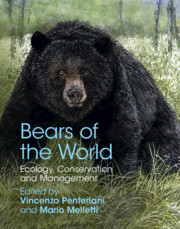Book contents
- Bears of the World
- Bears of the World
- Copyright page
- Dedication
- Frontispiece
- Contents
- Contributors
- Foreword
- Acknowledgments
- Introduction
- Part I Systematics, Ecology, and Behavior
- Part II Species Accounts
- Part III Human–Bear Coexistence
- Part IV Conservation and ManagementConservation and Management
- Chapter 20 Conservation and Management of Bears
- Chapter 21 How Is Climate Change Affecting Polar Bears and Giant Pandas?
- Chapter 22 Managing for Interpopulation Connectivity of the World’s Bear Species
- Chapter 23 Ex Situ Conservation of Bears: Roles, Status, and Management
- Chapter 24 The Challenge of Brown Bear Management in Hokkaido, Japan
- Chapter 25 Potential Ecological Corridors for Remnant Asiatic Black Bear Populations and its Subpopulations Linked to Management Units in Japan
- Chapter 26 Captive Bears in Asia: Implications for Animal Welfare and Conservation
- Chapter 27 Human Dimensions of Asiatic Black Bear Conflicts and Management in Japan
- Chapter 28 Ecological and Social Dimensions of Sloth Bear Conservation in Sri Lanka
- Index
- Miscellaneous Endmatter
- Plate Section (PDF Only)
- References
Chapter 27 - Human Dimensions of Asiatic Black Bear Conflicts and Management in Japan
from Part IV - Conservation and ManagementConservation and Management
Published online by Cambridge University Press: 16 November 2020
- Bears of the World
- Bears of the World
- Copyright page
- Dedication
- Frontispiece
- Contents
- Contributors
- Foreword
- Acknowledgments
- Introduction
- Part I Systematics, Ecology, and Behavior
- Part II Species Accounts
- Part III Human–Bear Coexistence
- Part IV Conservation and ManagementConservation and Management
- Chapter 20 Conservation and Management of Bears
- Chapter 21 How Is Climate Change Affecting Polar Bears and Giant Pandas?
- Chapter 22 Managing for Interpopulation Connectivity of the World’s Bear Species
- Chapter 23 Ex Situ Conservation of Bears: Roles, Status, and Management
- Chapter 24 The Challenge of Brown Bear Management in Hokkaido, Japan
- Chapter 25 Potential Ecological Corridors for Remnant Asiatic Black Bear Populations and its Subpopulations Linked to Management Units in Japan
- Chapter 26 Captive Bears in Asia: Implications for Animal Welfare and Conservation
- Chapter 27 Human Dimensions of Asiatic Black Bear Conflicts and Management in Japan
- Chapter 28 Ecological and Social Dimensions of Sloth Bear Conservation in Sri Lanka
- Index
- Miscellaneous Endmatter
- Plate Section (PDF Only)
- References
Summary
This chapter describes human dimensions studies on black bear management conducted in Japan, by reporting: (1) a study on the media coverage regarding black bear issues in Japan; (2) the results from interviews and surveys that were conducted on local residents of the northern part of Hyogo Prefecture regarding their attitudes and behaviors related to human–bear conflicts; (3) the effectiveness of community seminars in mitigating human–black bear conflicts; and (4) how human–bear conflicts could be used to educate university students and train them to potentially become wildlife managers.
- Type
- Chapter
- Information
- Bears of the WorldEcology, Conservation and Management, pp. 370 - 378Publisher: Cambridge University PressPrint publication year: 2020

